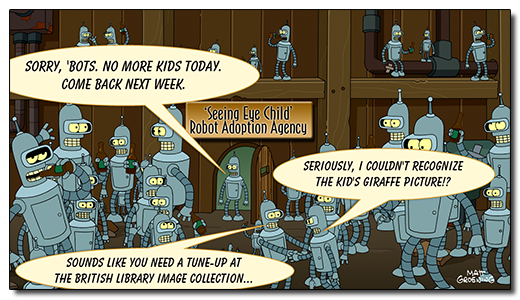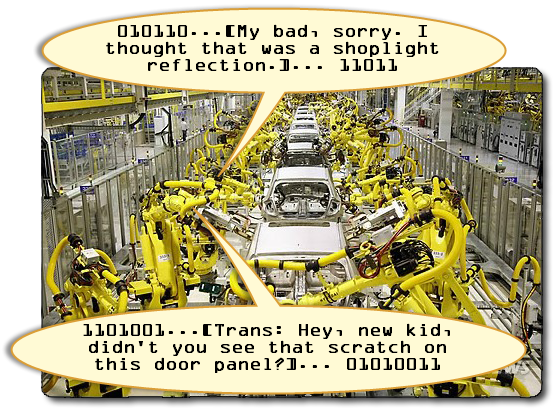In the first part of this informal proposal to creatively tap the newly-published British Library Image Collection, I imagined a plug-in game to be developed as part of the FactMiners social-game ecosystem. In this adult/child-interactive early-learning app, gameplayers collectively contribute to building a Fact Cloud of "What's in this picture" facts (elementary sentence-like assertions stored in a graph database) for the over one-million images recently uploaded to the Flikr Commons. Parents playing this new word/picture FactMiners plug-in game with their kids create the Fact Cloud that becomes a vital resource for a second new FactMiners game; the 'Seeing Eye Child' Robot Adoption Agency.

The Robot Adoption Agency is similar to the 'Tamagotchi' or 'digital pet' gaming phenomena that hit in the mid-1990's and is still going strong. The difference here is that we harness our little cognitive learning machines – AKA FactMiners game players – to 'adopt' a robot (AKA a machine-learning program with some form of vision – image intake and analysis – capability) and help it to learn to see and understand its world. As an adoptive 'Seeing Eye Child', players take on the roles of coach and referee for training sessions where adopted robots learn to see what's in the British Library images.
The nimble-thinking among you have likely spotted the weak link in this proposed game design... robot supply.

Are we honestly to believe that the latest industrial robots ready to be brought on-line to a Ford or Toyota auto assembly line are in need of vision-training sessions with young kids mentoring their ability to recognize scenes from 17th-19th century book illustrations? Well, that is most certainly not the case.
So how can the Fact Cloud creators – those playing the word/picture FactMiners game that creates the Fact Cloud descriptive companion to the British Library Image Collection – how can these players be motivated to create that Fact Cloud if its imagined great use in robot vision training turns out not to be a need at all? What kid is going to wait around a Robot Adoption Agency match-making server's 'waiting room' for an adoptable robot that may never show up?
Fortunately we can consider both the means and the ends of the Fact Cloud creation effort to answer such important questions. From a 'means value' perspective, the image-describing FactMiners gameplay that creates the Fact Cloud is a fun, social, interactive learning activity. There is an immediate and personal motivation and value for parents, siblings, tutors, and teachers to help little learners build the British Library Image Collection Fact Cloud. So even if the robot vision training need were to turn out to be an elusive future-imagining, the 'serious fun' of building the British Library Image Collection Fact Cloud is time and energy well-spent in direct, interactive childhood and developmental educational activity.
Having 'means-tested' the effort to create the British Library Image Collection Fact Cloud, in my next post I will turn our attention to the 'ends' test – Will we really have a robot supply problem at the 'Seeing Eye Child' Robot Adoption Agency?...
Recent comments